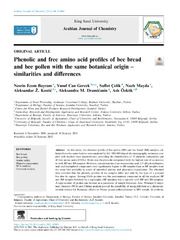Приказ основних података о документу
Phenolic and free amino acid profiles of bee bread and bee pollen with the same botanical origin – similarities and differences
| dc.creator | Bayram, Nesrin Ecem | |
| dc.creator | Gercek, Yusuf Can | |
| dc.creator | Çelik, Saffet | |
| dc.creator | Mayda, Nazlı | |
| dc.creator | Kostić, Aleksandar Ž. | |
| dc.creator | Dramićanin, Aleksandra M. | |
| dc.creator | Özkök, Aslı | |
| dc.date.accessioned | 2021-08-04T10:40:37Z | |
| dc.date.available | 2021-08-04T10:40:37Z | |
| dc.date.issued | 2021 | |
| dc.date.issued | 2021 | |
| dc.identifier.issn | 1878-5352 | |
| dc.identifier.issn | 0023-6438 | |
| dc.identifier.uri | https://www.sciencedirect.com/science/article/pii/S1878535221000198 | |
| dc.identifier.uri | https://cherry.chem.bg.ac.rs/handle/123456789/4491 | |
| dc.description.abstract | In this study, the chemical profile of bee pollen (BP) and bee bread (BB) samples collected from the same beehive were analyzed by LC–MS/MS (liquid chromatography technique coupled with tandem mass spectrometry), providing the identification of 23 phenolic compounds and 42 free amino acids (FAAs). Rutin was the phenolic compound with the highest rate of occurrence in both BP and BB samples. However, concentrations of protocatechuic acid, 2,5-dihydroxybenzoic acid and kaempferol compounds were significantly higher in BB samples than in BP samples from the same hive probably as result of microbial activity and glycosides degradation. The obtained data revealed that the phenolic profiles of the samples differ not only by the type of a product but also by region. Among FAAs proline was the predominant compound in all the analyzed BP and BB samples followed by l-asparagine (BP samples) and l-aspartic acid (BP and BB samples). A high content of proline can be used as a parameter of sample freshness. Also, Principal Component Analysis (PCA) and Cluster analysis proved the possibility of using phlorizin as a chemotaxonomic marker for Rosaceae (Malus or Prunus genus) pollen presence in BP1 sample. In addition, amino acid profile had higher impact on BP and BB sample differentiation due to lower FAAs content in BB samples probably caused by microbial activity. To the best of our knowledge, this study is the first to compare the individual phenolic compounds and free amino acids of bee pollen and bee bread samples with the same botanical origin (predominantly originated from plants belonging to the following families: Asteraceae, Fabaceae, Plantaginaceae and Rosaceae). | |
| dc.language | en | |
| dc.publisher | Elsevier | |
| dc.relation | Hacettepe University (FHD-2018-16748) | |
| dc.relation.isreferencedby | https://cherry.chem.bg.ac.rs/handle/123456789/4492 | |
| dc.rights | openAccess | |
| dc.rights.uri | https://creativecommons.org/licenses/by-nc-nd/4.0/ | |
| dc.source | Arabian Journal of Chemistry | |
| dc.source | Arabian Journal of Chemistry | |
| dc.subject | Amino acids | |
| dc.subject | Bee bread | |
| dc.subject | Bee pollen | |
| dc.subject | Chemical analysis | |
| dc.subject | PCA analysis | |
| dc.subject | Phenolic compounds | |
| dc.title | Phenolic and free amino acid profiles of bee bread and bee pollen with the same botanical origin – similarities and differences | |
| dc.type | article | en |
| dc.rights.license | BY-NC-ND | |
| dcterms.abstract | Маyда, Назлı; Драмићанин, Aлександра М.; Баyрам, Несрин Ецем; Герцек, Yусуф Цан; Çелик, Саффет; Костић, Aлександар Ж.; Öзкöк, Aслı; | |
| dc.citation.volume | 138 | |
| dc.citation.spage | 110739 | |
| dc.identifier.wos | 000623519700037 | |
| dc.identifier.doi | 10.1016/j.arabjc.2021.103004 | |
| dc.citation.rank | M21~ | |
| dc.description.other | Supplementary material: [https://cherry.chem.bg.ac.rs/handle/123456789/4492] | |
| dc.type.version | publishedVersion | |
| dc.identifier.scopus | 2-s2.0-85100110106 | |
| dc.identifier.fulltext | https://cherry.chem.bg.ac.rs/bitstream/id/27265/Phenolic_and_free_pub_2021.pdf |


